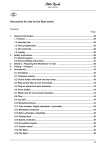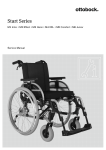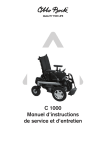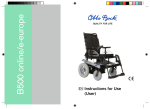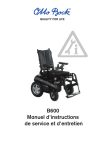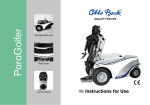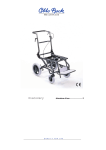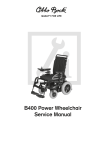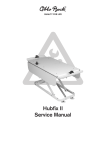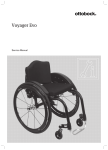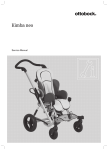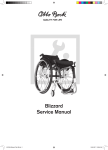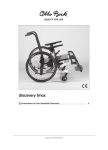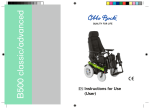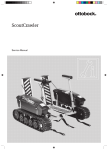Download instruction for use
Transcript
BRAVOracer Service Manual Service Manual for the BRAVO Racer Active Wheelchair Table of contents Page 1 Introduction........................................................................................................................3 1.1 Foreword......................................................................................................................3 1.2 Technical support........................................................................................................3 1.3 Explanation of symbols...............................................................................................3 2 General safety instructions................................................................................................4 3 Required tools, maintenance schedule.............................................................................5 3.1 Required tools.............................................................................................................5 3.2 Maintenance schedule................................................................................................7 4 Adjustments / replacement / retrofitting...........................................................................8 4.1 Assembly A: Frame.....................................................................................................8 4.1.1 Retrofitting the multi-function adapter for frame accessories.......................................... 8 4.1.2 Retrofitting / replacing / adjusting the tip-assist............................................................. 9 4.1.3 Retrofitting / replacing the anti-tipper.............................................................................. 9 4.1.4 Retrofitting / replacing / adjusting the transport wheels............................................... 10 4.1.5 Retrofitting / replacing the crutch holder....................................................................... 10 4.2 Assembly B: Footrest................................................................................................ 11 4.2.1 Adjusting / replacing the footplate................................................................................. 11 4.2.2 Adjusting the lower leg length........................................................................................ 12 4.2.3 Adjusting the footplate angle......................................................................................... 13 4.2.4 Replacing / retrofitting the lateral heel blocks on the footplate . ................................. 14 4.3 Assembly C: Seat......................................................................................................15 4.3.1 Replacing the seat upholstery / upholstery bars........................................................... 15 4.3.2 Replacing / removing the adjustment tube.................................................................... 16 4.3.3 Vertical seat adjustment................................................................................................. 16 4.3.4 Horizontal seat adjustment............................................................................................. 17 4.3.5 Adjusting the seat angle................................................................................................. 18 4.3.6 Adjusting the seat depth................................................................................................. 18 4.3.7 Fine adjustments to the back unit.................................................................................. 19 4.3.8 Adjusting the seat width................................................................................................. 20 4.4 Assembly D: Back / push handles...........................................................................23 4.4.1 Replacing the back release............................................................................................ 23 4.4.2 Replacing the back release spring................................................................................. 23 4.4.3 Replacing the push handles: Standard / folding version............................................... 24 4.4.4 Replacing the push handles: Height-adjustable version................................................ 24 4.4.5 Retrofitting the push bar................................................................................................. 25 4.4.6 Replacing the back upholstery....................................................................................... 26 4.4.7 Pre-adjusting the back angle.......................................................................................... 27 4.5 Assembly E: Side panels..........................................................................................28 4.5.1 Adjusting the side panels: Clothing protector version.................................................... 28 4.5.2 Replacing the side panels: Clothing protector version.................................................. 28 4.5.3 Adjusting the side panels: Height-adjustable version.................................................... 29 4.5.4 Replacing the side panels: Height-adjustable version................................................... 29 4.5.5 Replacing the arm pad / lengthwise adjustment........................................................... 30 4.6 Assembly F: Casters.................................................................................................30 4.6.1 Replacing the caster axle................................................................................................ 30 4.6.2 Removing / replacing the casters.................................................................................. 31 4.6.3 Replacing the caster forks.............................................................................................. 32 4.7 Assembly G: Rear wheels.........................................................................................32 4.7.1 Centre of gravity and seating position............................................................................ 32 4.7.2 Replacing the rear wheel attachment assembly............................................................ 32 4.7.3 Replacing the fitting and camber adapter...................................................................... 33 4.7.4 Installing a wheelbase extension.................................................................................... 33 4.7.5 Retrofitting the rear wheels with drum brakes............................................................... 34 4.7.6 Adjusting the quick-release axle..................................................................................... 36 4.7.7 Changing tyres................................................................................................................ 37 4.7.8 Replacing the push rings – narrow / wide mounting position........................................ 37 4.7.9 Replacing / retrofitting spoke protectors........................................................................ 37 4.8 Assembly H: Wheel lock...........................................................................................38 4.8.1 Adjusting the wheel lock................................................................................................. 38 4.8.2 Replacing the wheel lock................................................................................................ 39 4.9 Accessories...............................................................................................................40 4.9.1 Installing the lap belt....................................................................................................... 40 5 Technical data..................................................................................................................41 1 Introduction 1.1 Foreword Regular maintenance is important – it improves the safety and increases the lifespan of the product. All mobility products should be inspected and serviced once a year. If the product is frequently used, or if it is used by growing children or patients with changing clinical conditions, we recommend readjusting and servicing the product every 6 months. Only use original spare parts for all service and maintenance. The service and maintenance tasks described here should only be completed by trained, qualified personnel and not by the wheelchair user. This service and maintenance manual refers to the spare parts catalogues and instructions for use for the products described. Please use these documents together. Use photocopies of the maintenance schedule (checklist in Section 3.2). Retain completed maintenance schedules and provide the customer with a copy. BRAVO Racer Instructions for Use 647G447=D/GB Spare Parts Catalogue 1.2 Technical support Your national Otto Bock Team will be pleased to answer your technical questions. Contact addresses and telephone numbers are listed on the last page of this manual. 1.3 Explanation of symbols Caution! Personal injury warning. Attention! Product damage warning. Note! Useful tips for the technician. Please read! Please read the Instructions for Use first! 2 General safety instructions Observe the following guidelines for maintenance or repair work: Caution! Use appropriate tools (refer to pages 5 ff.). Caution! Wear appropriate clothing, including gloves and protective goggles if required. Attention! Secure the product to prevent it from tipping over or falling off the workbench. Please read! Please read the service and maintenance instructions before commencing work. Please read! You should become familiar with the functions of the product first. If you are not familiar with the product, read the instructions for use before inspecting the product. If you do not have a copy of the instructions for use, you can order one from the manufacturer (see the overview of all Otto Bock branches “Otto Bock Worldwide”). You can also download documents from our homepage: www.ottobock.de or www.ottobock.com. Attention! Clean or disinfect the product before you start the inspection. Consult the instructions for use regarding product care or product specific inspection information. Attention! The screws and nuts for many of the screw connections are coated with thread lock. If such screws must be replaced or the connections undone, be sure to use a new screw or nut coated with threadlock. If new screws or nuts with thread lock are not available, apply a medium-strength liquid thread lock substance (such as Loctite 241 or Euro Lock A24.20) to the existing screws. 3 Required tools, maintenance schedule 3.1 Required tools The following list shows the tools and accessories required for service. Ratchet wrench and socket set, sizes 8 – 24 Torque wrench, measurement range 5 – 50 Nm Wrenches, sizes 10 – 24 Allen wrenches, sizes 3 – 6 Screwdrivers, blade widths 2.5, 3.5, and 5.5 mm Phillips screwdriver, size 2 Plastic hammer Hammer, approximately 300 g Stanley knife with sickle hooked blade and standard blade Side cutting pliers Liquid thread lock “medium strength” Rivet gun for rivets up to ø 5mm Workbench and vice with plastic jaws and rubber insert Hand drill Tyre mounting levers and inner tube repair kit 3.2 Maintenance schedule Maintenance schedule for regular inspections Item BRAVO Racer - active wheelchair - Inspection (checklist) Component (assembly) Serial number: Customer: 1.) Function / setting (refer to 647G447GB Instructions for Use) 2.) Damage / deformation 3.) Screw connections A Frame - Base frame x x Footrest C Seat - Lengthwise setting - Lower leg length setting - Angle adjustment x x x x x x x B - Anti-tipper - Transport wheels - Crutch holder - Tip-assist x x x D Back / push handle - Seat upholstery - Lengthwise adjustment of the seating unit - Seat height - Seat cushion E Side panel F Caster G Frame accessories Rear wheel Rear wheel accessories H S Wheel lock Wheel lock accessories Accessories Do the settings of the wheelchair comply with the user’s requirements? x x x x x x x x - Back upholstery - Back tubes - Folding mechanism - Push handles - Push bar x x x x x x x x x - Tyres (wear) - Air pressure - Running characteristics of the wheels - Threaded axles - Swivelling characteristics of the wheel forks x x x x x x x - Height setting - Retracting mechanism - Removability x x x - Tyres (wear) - Air pressure - Running characteristics of the wheels - Spokes - Push rings - Quick-release axles - Wheel camber - Rear wheel attachment x x x x x x x x - Spoke protectors - Wheelbase extension x x - Wheel lock function - Lever assembly - Clamp fittings - Pull-release cables x x x x x x x x x x x x x x x x - Wheel lock lever extension x x - Lap belt x x The maintenance service was carried out by: on: 4 Adjustments / replacement / retrofitting 4.1 Assembly A: Frame 4.1.1 Retrofitting the multi-function adapter for frame accessories Before mounting frame accessories (tip-assist, crutch holder, and transport wheels), a multifunction adapter must be installed. Please proceed as follows: First remove the rear wheels by pressing the button on the quick-release axle with your thumb and pulling off the wheel (Figure 1). Then loosen the cap nuts on the front of the rear wheel attachment (Figure 2) and remove them completely. Pull the U-shaped section off towards the rear (Figure 3). Loosen the counter nut on the top end of the adjustment tube and move the adjustment tube forward by several centimetres so that you have sufficient clearance for the installation (Figure 4). 1 3 2 4 Now push the hexagonal multi-function adapter past the loosened adjustment tube onto the exposed hexagon nut on the rear wheel axle (Figure 5). Secure the multi-function adapter using the clamping screw (Figure 6). 5 6 Reinstall the adjustment tube, rear wheel attachment, and wheels. Repeat the steps described above in reverse order. 4.1.2 Retrofitting / replacing / adjusting the tip-assist First, proceed as described in Section 4.1.1. Then press in the spring-mounted push button on the tip-assist and push the tip-assist onto the multi-function adapter to the desired mounting position (Figure 7). 4.1.3 Retrofitting / replacing the anti-tipper First, proceed as described in Section 4.1.1 up to the point where the adjustment tube is loosened. Now push the pre-assembled anti-tipper onto the exposed rear wheel axle until the anti-tipper adapter (hexagonal shape) is in place on the hexagon nut of the axle. Secure the anti-tipper using the clamping screw (Figure 8) and test the swing-away and locking functions. 7 8 Note! Subject to technical changes. 4.1.4 Retrofitting / replacing / adjusting the transport wheels First, proceed as described in Section 4.1.1. Follow the same process to install a second multifunction adapter across from the rear wheel attachment in order to attach the transport wheels on both sides. Then press in the spring-mounted push button on the transport wheel (Figure 9) and push it onto the multi-function adapter to the desired mounting position. Follow the same procedure on the other side. 9 4.1.5 Retrofitting / replacing the crutch holder First, proceed as described in Section 4.1.1. Then press in the spring-mounted push button on the crutch holder (Figure 10) and push the crutch holder onto the multi-function adapter to the desired mounting position. Attach the hook and loop strap to hold the crutches to the back tube. To replace the bucket, loosen the screw connection on the bottom and remove the bucket (Figure 11). Put a new bucket in place and secure it with the screw removed from the old one. 10 10 11 4.2 Assembly B: Footrest 4.2.1 Adjusting / replacing the footplate If the footplate is too small or has become damaged, or if the leg length needs to be adjusted due to the growth of a child, proceed as follows: First, completely loosen all screws on the clamps on the top of the footplate and remove them (Figure 12). The footplate can be moved forward in the following ways: a)Fine adjustment: Move the footplate on the footrest bars without following any additional steps. Retighten the screws. b)Larger adjustments: Pull the footplate off the footrest bars (Figure 13). Loosen and reposition the clamps (Figure 14); then proceed as described under a). Note: The approach allows you to mount the footplate further forward and closer to the frame. c)Replacement: Loosen all screws on the top and the the clamps. Mount the footplate as described above. 12 13 14 11 4.2.2 Adjusting the lower leg length The lower leg length can be adjusted as follows: a)Fine adjustment of the lower leg length: Loosen the outer screws on the clamps that guide the footrest bars (Figure 15) and adjust the footplate to the desired height. b)Changing the lower leg length (from long to short or short to long): Remove the footplate, and then remove the exposed footrest bars. Turn the footrest bars around (Figure 16) and reinstall them. Put the footplate back in place and retighten all screws (Figure 17). 15 17 Note! Follow the same process to replace the footrest bars. 12 16 4.2.3 Adjusting the footplate angle First, loosen the set screws on the clamps that hold the T-shaped crossbrace (Figure 18). Loosen the centre Allen screws on the same clamps so you can open the rotation joint (Figure 19). Then open the screw connections located on the frame tube between the clamps (Figure 20). Now loosen the crossbrace screw connection on the seat tube (Figure 21), so that the nuts can move freely in the guide groove. 18 20 19 21 13 Move the crossbrace back along the seat tube until the footplate reaches the desired angle (Figure 22). Use the scale on the bottom of the seat tube (Figure 23) in order to make sure the footplate is positioned evenly on both sides. 22 23 Retighten all screws. Note! On wheelchairs with narrow seats, the footplate is mounted in the centre (Figure 24). 4.2.4 Replacing / retrofitting the lateral heel blocks on the footplate The lateral heel blocks are attached to the bottom of the footplate using screws or rivets. You have to drill the required bore holes. The positions are pre-punched on the footplate (Figure 25). 24 14 25 4.3 Assembly C: Seat 4.3.1 Replacing the seat upholstery / upholstery bars First remove the seat cushion. Remove the front tube end caps (Figure 26). Loosen the hook-and-loop connections on the tension-adjustable upholstery in order to slacken it (Figure 27). Evenly pull the seat upholstery and upholstery bars out of the guides towards the front (Figure 28) (use pliers if required). Either re-use the same upholstery bars or replace them with new ones. Insert the upholstery bars into the loops on the new seat upholstery, if required. Reinsert the upholstery bars into the guides on the seat tube (Figure 29) and pull them back evenly. Refasten the hook-and-loop connections on the tension-adjustable upholstery. Reinsert the tube end caps. 26 28 27 29 15 4.3.2 Replacing / removing the adjustment tube Remove the rear wheels, rear wheel attachment, and U-shaped component as described under 4.1.1. Loosen the counter nut on the top of the adjustment tube (Figure 30) and remove it. Replace the adjustment tube, counter nut, or guide bushings with new parts as required (Figure 31). Remove the guide bushings from the adjustment tube and insert them in the desired position (Figure 32). Move the U-shaped component to the new position. Follow the same procedure on the other side. 30 31 32 4.3.3 Vertical seat adjustment Fully loosen the two cap nuts on the front of the adjustment tube (Figure 33) and remove them. Now pull the U-shaped component back (Figure 34) until you can move the adjustment tube up and down freely. Follow this procedure on both sides. Then loosen the two outer screws on the front of the clamps that guide the footrest bar and crossbrace so that the crossbrace moves freely inside the clamp (Figure 35). Reposition the adjustment tube over the hole channel (Figure 36). Position the guide bushings in the corresponding locations (see Section 4.3.2). For assembly, please proceed in reverse order. Retighten all screws. 16 33 35 34 36 4.3.4 Horizontal seat adjustment Remove the rear wheels. Loosen the counter nuts on the top end of the adjustment tubes. Loosen the screw connections on both sides of the crossbrace in the guide grooves of the seat tubes (Figure 37). Move the seat tubes lengthwise until they reach the desired position (Figure 38). Use the scale on the bottom of the seat tubes in order to make sure the position is even on both sides. Retighten all screws. 37 38 17 4.3.5 Adjusting the seat angle Slightly loosen the two cap nuts on the front of the adjustment tube. Follow this procedure on both sides. Then loosen the two inner screws on the front of the footrest clamps (Figure 39; for narrow seats, loosen the outer screws) and the countersunk centre screws (Figure 40) until the crossbrace moves easily inside the clamp. Move the crossbrace vertically inside the clamps in order to adjust the seat angle. The rear wheel axle (Figure 41) is the rotation point. The footrest angle follows automatically. Once the desired angle is set, retighten all screws. 39 40 41 4.3.6 Adjusting the seat depth Remove the rear wheels. Loosen the counter nuts on the top end of the adjustment tubes. Loosen the screw connections on both sides of the crossbrace in the guide grooves of the seat tubes. Loosen the four screw connections / nuts of the back unit on the seat tubes (Figure 42). Loosen the screw connections on both sides below the lip of the clothing protector (Figure 43). Now you can push the seat tubes with seat upholstery forward in order to increase the seat depth (Figure 44). Use the scale on the bottom of the seat tubes in order to make sure the position is even on both sides. Retighten all screws. 18 42 43 44 4.3.7 Fine adjustments to the back unit If a solid back is used in place of the back upholstery, the back unit can be adjusted separately in order to optimise the seating position. Remove the rear wheels. Loosen the four seat tube screw connections / nuts of the back unit on the seat tubes so that you can move it freely later. Then loosen the back tube screw connections on the side panels (Figure 45). Now move the back unit on the seat tubes until it reaches the desired position (Figure 46). Use the scale on the bottom of the seat tubes in order to make sure the position is even on both sides. Retighten all screws. 19 45 46 4.3.8 Adjusting the seat width Adjusting the seat width requires a conversion kit (consult the spare parts catalogue) and a new seat cushion. The conversion kit includes a crossbrace and back unit in the new seat width, and an installation kit. We recommend replacing the upholstery as well. a) Removing the seat: First remove the seat cushion, seat upholstery, and front tube end caps. Loosen the hook-andloop connections on the tension-adjustable upholstery in order to slacken it. Evenly pull the seat upholstery and upholstery bars out of the guides towards the front (use pliers if required) (Figure 47). Now remove the push handles and back upholstery as described in Section 4.4.3/4.4.4 and 4.4.6. If clothing protectors are installed, remove the screw connections underneath the lip of the clothing protector (Figure 48). 47 20 48 Remove the back plate screw connections on both sides of the back part (Figure 49). Now you can remove the back part. Replace the back part with the new unit. Loosen and remove the crossbrace screw connections on the seat tube (Figure 50) and the crossbrace screw connections on the footrest clamps (Figure 51). Also loosen the footrest screw connections on the footrest clamps until the footrest can be turned on the frame tube (Figure 52). Pull the crossbrace out towards the front. 49 51 50 52 21 b) Widening the seat surface: Loosen and remove the rear wheel attachment (Figure 53). Move the U-shaped component into the outer notches of the camber adapters on both sides (Figure 54). Proceed in the reverse sequence in order to install the rear wheel attachment. Now insert the new crossbrace into the footrest clamps and screw them back onto the seat tubes. Use the scale to ensure the position is the same on both sides. 53 54 c) Finishing the back unit: Now mount the push handles (see Section 4.4.3) and the back upholstery (see Section 4.4.6) onto the new back unit. Mount the back unit to the back plates and to the side panels if applicable. To do so, proceed in reverse order. Finally, reattach the back upholstery flap. d) Finishing the seating unit: Reinstall the seat upholstery and upholstery bars onto the seat tubes (see Section 4.3.1). Close the seat tubes with the tube end caps. Replace the seat cushion with a new one. Finally, check that all screw connections are tight. 22 4.4 Assembly D: Back / push handles 4.4.1 Replacing the back release Remove the seat cushion. Unlock the back rest and fold it ahead to the stop (Figure 55). Lift the back upholstery flap. Using pincers, pinch off the release cable from both key rings (Figure 56). Open the key rings slightly and remove them from the ends of the bolts (Figure 57 – keychain principle). Turn new key rings into the new release cable, which will be delivered pre-assembled, and then turn the key rings into the bolt ends. Test the back release for proper function. 55 56 57 4.4.2 Replacing the back release spring Remove the seat cushion. Unlock the back rest and fold it ahead to the stop. Lift the back upholstery flap. Remove the upper screw connection on both back plates (Figure 58). Pull the back tubes towards the back until they are exposed. Remove the key rings from the back release assembly (Figure 59). Note that ratchet bolts are under outward spring tension. Replace the springs / ratchet bolts if required. For assembly, please proceed in reverse order. 23 58 59 4.4.3 Replacing the push handles: Standard / folding version First remove the back upholstery flap. Open the strap that covers the push handle screw connections and pull it off towards the bottom (Figure 60). If applicable, remove the upper upholstery strap (in case of folding push handles). Loosen the push handle screw connections on the rear of the back tubes (Figure 61) and pull the push handles up and out / off the back tubes. Replace the push handles with the desired version or with new parts. For assembly, please proceed in reverse order. 60 61 4.4.4 Replacing the push handles: Height-adjustable version First remove the back upholstery flap (Figure 62). Loosen and remove the outer screws from the clamps, and remove the strap (Figure 63). Loosen the four screws on the inside of the clamps (Figure 64) and remove them. Pull the push handles up and out of the back tubes. Replace the push handles with the desired version or with new parts. For assembly, please proceed in reverse order. 24 62 63 64 4.4.5 Retrofitting the push bar Remove the rear wheels. Remove the rear tube end caps from the seat tubes on both sides (Figure 65). Insert the supplied nuts into the seat tube grooves from the rear (Figure 66). Position the support bar against the seat tubes from below (Figure 67) and screw the support bar connectors into the nuts (Figure 68). Insert the support bar approximately 2 cm along the seat tube groove and tighten the screws. 65 66 25 67 68 Insert the tube end caps. Now the push bar can be secured using the quick clamp (Figure 69; consult the instructions for use). 69 4.4.6 Replacing the back upholstery Proceed as described in Section 4.4.3 until you have removed the push handles. Loosen all hook-and-loop straps from the old back upholstery (Figure 70). Then pull all strap loops located above the back stabiliser up and off the back tubes. Unlock the back rest and fold it ahead to the stop. Remove the upper screw connection on both back plates (Figure 71). Pull the back tubes towards the back until they are exposed. Remove the back release key rings as described in Section 4.4.1. Open the hook-and-loop straps on the back upholstery. Remove all hook-and-loop straps below the back stabiliser and then install the new back upholstery (Figure 72). For assembly, please proceed in reverse order. 26 70 71 72 4.4.7 Pre-adjusting the back angle First remove the rear wheels. Then loosen the screws on both sides of the side panel guides (Figure 73) and remove them. Push the side panel up and out of the way. Now you can access the back angle pre-adjustment mechanism on the back plates. Remove the pre-adjustment screws on both sides (Figure 74) and position the back as desired. Once you have found the desired position, tighten the screws. For assembly, please proceed in reverse order. 73 74 27 4.5 Assembly E: Side panels 4.5.1 Adjusting the side panels: Clothing protector version Loosen the screw below the lip of the clothing protector and the side panel mounting screw in the nut on the seat tube (Figure 75). Move the side panels lengthwise until they reach the desired position (Figure 76). Use the scale on the bottom of the seat tubes in order to make sure the position is even on both sides. Retighten all screws. 75 76 4.5.2 Replacing the side panels: Clothing protector version Loosen and remove the screw connection below the lip of the clothing protector, and the screw on the eccentric disk (Figure 77). Now you can remove the side panel. Draw the pull-release cable down and out of the guide, and unhook it from the wheel lock lever (Figure 78). Replace the side panel with a new one. For assembly, please proceed in reverse order. 77 28 78 4.5.3 Adjusting the side panels: Height-adjustable version Loosen the two side panel mounting screws in the nuts on the seat tube (Figure 79). Move the side panels lengthwise until they reach the desired position (Figure 80). Use the scale on the bottom of the seat tubes in order to make sure the position is even on both sides. Retighten all screws. 79 80 4.5.4 Replacing the side panels: Height-adjustable version Loosen and remove the two screw connections on the outside of the side panel attachment (Figure 81). Now you can remove the side panel. Draw the pull-release cable down and out of the guide, and unhook it from the wheel lock lever (Figure 82). Replace the side panel with a new one. For assembly, please proceed in reverse order. 81 82 29 4.5.5 Replacing the arm pad / lengthwise adjustment Loosen and remove the two screws on the bottom of the arm pad (Figure 83). Replace the arm pad with a new one if required. Replace the arm pad in the desired position (Figure 84; three possible settings) and retighten the screw connections. (1) 83 (2) (1, 3) (2) (3) 84 4.6 Assembly F: Casters 4.6.1 Replacing the caster axle Remove the dust protection cap (Figure 85). Loosen and remove the axle screw connection (Figure 86). Pull the caster fork and axle down and out of the housing and remove the axle (Figure 87). Note the location and number of spacer washers in the housing; these need to be replaced in the correct position during assembly. Replace the axle with a new one. For assembly, please proceed in reverse order. 85 30 86 87 4.6.2 Removing / replacing the casters Remove the two outside caster screw connections on the caster fork (Figure 88). Remove the caster and spacers. Replace the caster, ball bearing, and spacers with new parts as required (Figure 89). Insert the caster into the desired / correct bore hole on the caster fork (Figure 90; also consult the technical data). 88 89 90 31 4.6.3 Replacing the caster forks To replace the caster forks, first proceed as described in Section 4.6.1. Replace the caster fork with a new part or a different length fork if applicable. Insert the axle into the caster fork. If you changed the position of the caster or the length of the fork, you can level the frame using the spacers (Figure 91). Retighten all screws. 91 4.7 Assembly G: Rear wheels 4.7.1 Centre of gravity and seating position Unlike wheelchairs such as the Blizzard, the centre of gravity and seating position for the BRAVO Racer active wheelchair are adjusted by changing the position of the seat on the base frame (see Section 4.3). The position of the frame always remains constant in relation to the ground. Therefore, the centre of gravity and seating position are not adjusted via the rear wheel position. 4.7.2 Replacing the rear wheel attachment assembly Fully loosen the two cap nuts on the front of the adjustment tube (Figure 92) and remove them. Remove the U-shaped component and the stops (Figure 93). Replace worn parts with new ones. For assembly, please proceed in reverse order. 92 32 93 4.7.3 Replacing the fitting and camber adapter First proceed as described in Section 4.7.2 to remove the U-shaped component. Loosen the counter nut on the exposed rear wheel fitting (Figure 94). Unscrew the fitting from the camber adapter by hand. To remove the camber adapter, drill out the rivet indicated in the illustration (Figure 95). Remove the camber adapter from the axle. Replace worn parts with new ones where required and / or replace the camber adapter with a different version. Follow this procedure on both sides. For assembly, please proceed in reverse order. 94 95 4.7.4 Installing a wheelbase extension First proceed as described in Section 4.7.2 to remove the U-shaped component on both sides. Insert the pre-assembled wheelbase extension into the adjustment tube over the rear wheel axle in place of the standard U-shaped components (Figure 96). 96 Use the stops and cap nuts to secure the wheelbase extension in exactly the same way as the standard U-shaped component. 33 Note! Any existing frame options (tip-assist, anti-tipper, crutch holder, transport wheels) must be moved to the rear axle during installation (see Section 4.1). 4.7.5 Retrofitting the rear wheels with drum brakes First proceed as described in Section 4.7.3. Unscrew the fitting from the camber adapter by hand. a) Mounting the brake drum: To secure the brake drum using the supplied extension fitting in the camber adapter, proceed as follows: Insert the fitting through the brake drum. Place the smaller counter nut onto the fitting (Figure 97), followed by the larger counter nut (Figure 98). Push the fitting through to the camber adapter while holding the counter nuts in the centre of the fitting (Figure 99). Tighten the fitting until the mounting place for the brake drum is flush with the camber adapter (Figure 100). Tighten the two counter nuts. 97 98 99 34 100 b) Preparing for brake handle installation: In order to mount the brake handle, you first have to make room for the installation on the push handle tube. Proceed as follows: Use a knife to carefully cut open the rubber grip, and then remove it from the push handle tube (Figure 101). Remove all adhesive and material residue. A solvent may be used for this purpose. Please observe any warnings provided by the manufacturer. Open the superglue package. Observe the instructions provided by the glue manufacturer. Use a spatula to apply adhesive all around the inside of the rubber grip, as deep as possible (Figure 102). Push the grip onto the push handle tube so that 25 mm remains between the grip and the bend in the tube (Figure 103). Allow the adhesive to cure fully. 101 102 103 35 c) Final assembly: Hold the brake handle of the drum brake in place in front of the rubber grip and tighten the screw on the mounting clamp (Figure 104). Adjust the pull-release cable of the drum brake using the adjustment nut (Figure 105). Follow this procedure on both sides. Attach the rear wheels and verify that the drum brake is working properly. Repeat the adjustment process if required. 104 105 4.7.6 Adjusting the quick-release axle The quick-release axle has to be adjusted so that the wheel is fully engaged, with no play on the axle. Use a wrench to hold the quick-release axle on the inside, and adjust it by turning the nut on the end of the quick-release axle in or out (Figure 106). 106 36 4.7.7 Changing tyres To replace worn tyres, first release the air from the inner tube by opening the valve. Remove the casing from the rim using standard tools available at bicycle shops, and then remove the inner tube and inspect the rim band as well as the inner rim surface for damage. Replace the inner tube and / or casing with new parts, and / or repair the tube by following the instructions provided with the repair kit. Insert the inner tube into the rim, starting with the valve. Pump it up slightly so that it assumes a round shape and place it around the rim (Figure 107). Then place the casing onto the rim and position it properly using standard tools. Ensure it is properly seated on the rim (Figure 108). Pump up the inner tube until it reaches the maximum operating pressure. This is indicated on the side wall of the tyre. Finally, reattach the dust cap onto the valve. 107 108 4.7.8 Replacing the push rings – narrow / wide mounting position First remove the tyres and inner tubes as described in Section 4.7.7. Loosen and remove the screw connection between the push ring and the rim. If necessary, replace the worn push ring with a new one. Reassemble the push ring to the rim. Attach it in the narrow or wide mounting position in relation to the rim by using the inner or outer bore holes on the push ring brackets (Figure 109). For the remainder of the installation, follow the steps described in Section 4.7.7. 4.7.9 Replacing / retrofitting spoke protectors Rear wheels with hollow rims or Infinity Ultralight rims can be equipped or retrofitted with spoke protectors. They are mounted with snap fasteners (so-called attachment nipples). Remove the rear wheels. If applicable, press out the attachment nipples of the worn spoke protector from the inside, e.g. with the handle of a hammer (Figure 110). Take the spoke protector or replace it with a new part. Position the spoke protector on the rim so that it is centred and you can see a spoke beneath each of the six bore holes. 37 From the outside, press in the attachment nipples until you hear them lock in place on the spokes. 109 110 4.8 Assembly H: Wheel lock 4.8.1 Adjusting the wheel lock Ensure that the rear wheel tyres are inflated to the proper operating pressure. When you replace the rear wheels with a different size, the wheel lock body first needs to be adjusted on the clamp. To do so, remove the two mounting screws from the wheel lock body (Figure 111). Position the wheel lock body so that approximately 3 mm remains between the brake block and the tyre (Figure 112). Fine adjustment is carried out using the two tension screws (Figure 113). Follow this procedure on both sides. 3 mm 111 38 112 113 4.8.2 Replacing the wheel lock a) Replacing the spring and pull-release cable: Unhook the pull-release cable from the adapters on the side panel as described in Section 4.5.4. Open the screw die in the brake block (Figure 114) and pull out the pull-release cable. You can remove the pull-release cable spring and replace it if required. Remove the anterior tension nut from the pull-release cable and completely unscrew the adjustment screw. Now the pull-release cable is fully removed. Replace the pull-release cable if required. For reassembly, proceed in the reverse order. Adjust the wheel lock as described in Section 4.8.1. 114 b) Replacing the wheel lock handle: Unhook the pull-release cable from the adapters on the side panel as described in Section 4.5.4. Use a screwdriver to remove the rubber grip from the wheel lock handle (Figure 115). Loosen the screw on the inside of the side panel until the wheel lock handle is fully removed (Figure 116). Replace the wheel lock handle with a new part. Mount the wheel lock handle by following the steps in the reverse order and hook up the pull-release cable. Use superglue to attach the new rubber grip to the wheel lock handle (see Section 4.7.5). 39 115 116 4.9 Accessories 4.9.1 Installing the lap belt Position the lap belt on the seat upholstery. Pull the free ends of the belt through between the side panel and the back tube on both sides. Screw the grommets on the ends of the belt into one of the unused bore holes on the back plate (Figure 117). Adjust the length of the lap belt using the glide buckles (Figure 118). 117 40 118 5 Technical data Seat width: Seat depth: Back height: Back angle: Lower leg length: Seat heights: Overall width: Overall length: Overall height: Weight: Load capacity: 20 – 36 24 – 38 20 – 40 Different settings possible from -15° to +15°, may be locked in place at +15° 14.5 – 44.5 31.5 – 46 With 20” rear wheel 34 – 48.5 With 22” rear wheel 36.5 – 51 With 24” rear wheel 47 – 63 48 – 66 At 9° camber 61.5 – 76.5 With 20” rear wheel 64 – 79 With 22” rear wheel 66.5 – 81.5 With 24” rear wheel 51.5 – 86 With 20” rear wheel 54 – 88.5 With 22” rear wheel Without push handles 56.5 – 91 With 24” rear wheel Approx. 8.5 kg 60 kg Seat height (in cm)1) Rear Wheel Size 20“ Camber 3° 6° 1 32.2 Adjustment 2 tube, short 3 22“ 9° 24“ 3° 6° 9° 3° 6° 9° 32.0 34.7 34.5 33.9 37.2 37.0 36.4 33.9 33.7 36.4 36.2 35.6 38.9 38.7 38.1 35.6 35.5 38.1 38.0 37.3 40.6 40.5 39.8 4 37.3 37.2 39.8 39.7 39.0 42.3 42.2 41.5 5 39.1 38.9 41.6 41.4 40.8 44.1 43.9 43.3 6 40.8 40.6 43.3 43.1 42.5 45.8 45.6 45.0 7 42.5 42.4 45.0 44.9 44.2 47.5 47.4 46.7 8 44.2 44.1 46.7 46.6 45.9 49.2 49.1 48.4 9 46.0 45.8 48.5 48.3 47.7 51.0 50.8 50.2 Position Adjustment tube, long 1) Specified at 0° seat angle, without seat cushion 41 Wheel / camber combinations 3° camber Rear Wheel Size 3“ Caster 4“ 5“ 140mm 20“ 6“ Caster 5“ 140mm 22“ 5“ 140mm 24“ 3“ Caster 5“ 140mm 20“ 6“ Caster 5“ 140mm 22“ 5“ 140mm 6“ 42 2 3 - 1 Number of Spacers - 1 - - 3 - - 3 - 1 1 - Number of Spacers 2 - 4 - 3 - 1 2 3 - 24“ Long Fork Position Short Fork Position 3 3“ Caster 1 1 6“ 4“ - - 3“ 4“ - 1 Rear Wheel Size 4“ 4 3 - 6“ 6° camber - 3 3“ Caster 2 1 6“ 4“ Number of Spacers - 3“ 4“ Short Fork Position - 1 1 2 4 4 1 - Long Fork Position Number of Spacers - 1 - - 3 - - 3 - 1 1 - 2 4 4 1 - 9° camber Rear Wheel Size Short Fork Position Number of Spacers Long Fork Position Number of Spacers 1 1 3 1 - 2 1 1 4 1 3“ Caster 4“ 5“ 140mm 20“ 6“ 3“ Caster 4“ 5“ 140mm 2 22“ - 6“ - 3“ Caster 4“ 5“ 140mm - 24“ 1 1 6“ 2 1 - 2 1 3 1 4 2 - - Colour combinations Translucent Design Side Panel brilliant silver sparkle bright orange snake clear red dormant vinho sparkle dormant marine blue dormant apple green candy red clear reptile glossy gecco style spooky yellow spooky blue Orange 145-15007 Blue 145-13040 Red 145-12018 x x x x x x x x x x x x x x x x x x x x x 43 44 Hersteller/Manufacturer: Otto Bock HealthCare GmbH Max-Näder-Straße 15 · 37115 Duderstadt/Germany National: Telefon (0 55 27) 848 1461/1462/1463 · Fax (0 55 27) 848 14 60 International: Phone +49-5527-848-1304/1562/1590/1594/3663 · Fax +49-5527-848-1676 e-mail: [email protected] · Internet: http://www.ottobock.com Otto Bock HealthCare GmbH Lindenstraße 13 · 07426 Königsee/Germany Otto Bock HealthCare GmbH has been certified by the German Society for the Certification of Quality Assurance Systems (DQS) in accordance with DIN EN ISO 9001 standard, reg. no. 779 (management system) © Otto Bock · 647G502=GB – 01.08 Versandanschrift für Rücksendungen/Address for Returns
















































